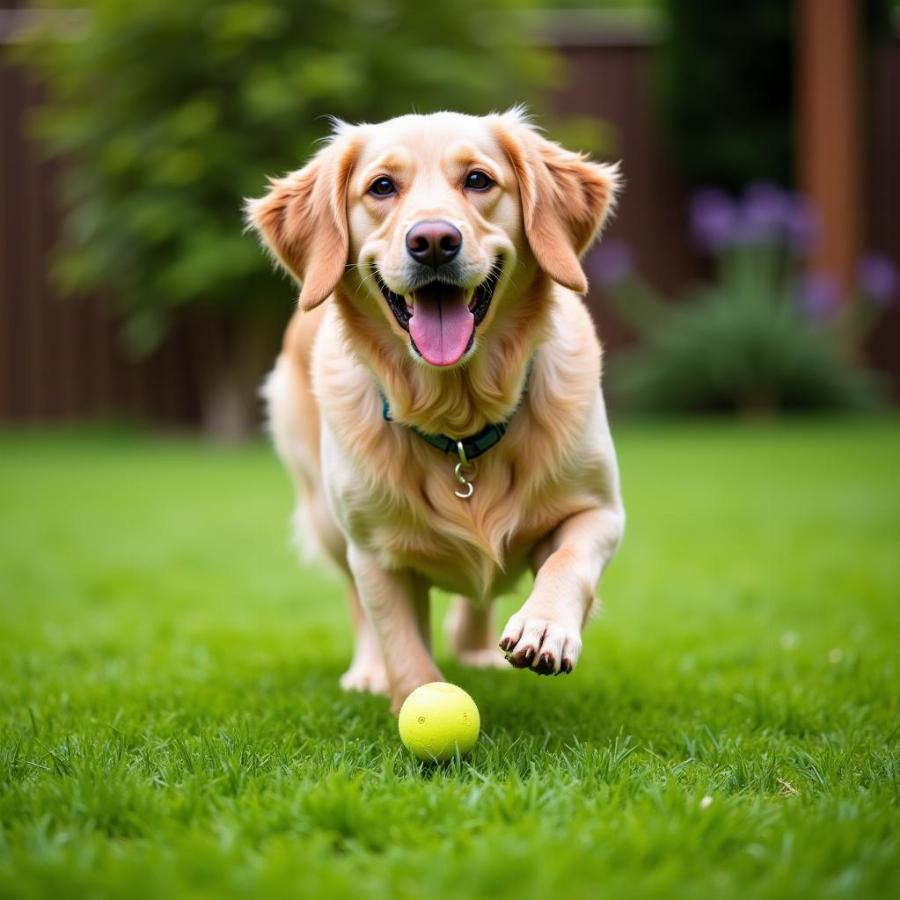Artificial grass has become a popular choice for dog owners looking for a low-maintenance and aesthetically pleasing alternative to natural grass. This guide will explore the benefits, drawbacks, and important considerations for choosing and maintaining artificial grass for your furry friends. We’ll cover everything from installation to cleaning, ensuring you’re well-equipped to make the best decision for your pet and your backyard.
Is Artificial Grass Safe for Dogs?
One of the primary concerns for dog owners is safety. Rest assured, modern artificial grass is designed with pet safety in mind. Most products are non-toxic and free of harmful chemicals. However, it’s crucial to choose high-quality artificial turf specifically designed for pets. Cheaper options may contain harmful substances or degrade quickly under heavy use. Always look for certifications and guarantees that ensure the product’s safety for animals. Additionally, the infill material used beneath the artificial turf plays a key role in drainage and odor control, which are crucial for dog-friendly lawns.
 Dog Playing on Artificial Grass
Dog Playing on Artificial Grass
Benefits of Artificial Grass for Dog Owners
Artificial grass offers a multitude of benefits for dog owners. Say goodbye to muddy paws tracking dirt into your home! Artificial grass provides a clean and consistent surface, minimizing mud and mess. It’s also incredibly durable, able to withstand heavy foot traffic and digging without becoming patchy or worn. This low-maintenance solution eliminates the need for mowing, watering, and fertilizing, saving you time and money. Plus, it’s always green, providing a beautiful and consistent lawn year-round.
Choosing the Right Artificial Grass for Your Dog
Selecting the right artificial grass involves considering factors such as pile height, density, and infill. A shorter pile height is generally recommended for dogs, as it’s easier to clean and less likely to trap debris. Denser turf provides better durability and resilience. The infill material is crucial for drainage and odor control. Opt for pet-specific infill options like zeolite or antimicrobial sand, which help neutralize pet waste odors. You can find more information about dog-friendly lawns on our artificial lawn dog page.
How to Install Artificial Grass for Dogs
Proper installation is key to a long-lasting and functional artificial lawn. Prepare the ground by removing existing grass and leveling the surface. Install a weed barrier to prevent unwanted growth. Lay the artificial turf and secure it with appropriate fixings. Finally, add the infill material and brush it into the turf. This process, although achievable as a DIY project, is often best left to professionals for optimal results.
Maintaining Your Artificial Grass Lawn
While artificial grass requires less maintenance than natural grass, regular cleaning is essential. Remove solid waste promptly and rinse the area with water. Periodically brush the turf to keep the blades upright and prevent matting. Use a pet-safe cleaner or a mixture of water and vinegar for deeper cleaning and odor removal. For more tips on maintaining a clean lawn for your dog, see our article on can dogs pee on artificial grass.
Is Artificial Grass Worth it for Dogs?
Considering the long-term benefits, artificial grass can be a worthwhile investment for dog owners. It eliminates the need for costly lawn care, provides a clean and safe environment for pets, and enhances the aesthetic appeal of your backyard. Although the initial cost might be higher than natural grass, the savings on maintenance and replacement over time can make it a cost-effective choice. If you’re considering alternatives, you can explore options like grass replacement for dogs.
Can My Dog Ruin Artificial Grass?
While artificial grass is highly durable, certain dog behaviors like excessive digging or chewing can potentially cause damage. Training your dog to avoid these behaviors is essential. Provide designated digging areas or chew toys to redirect their energy.
FAQs About Artificial Grass and Dogs
- Does artificial grass get hot in the sun? Yes, artificial grass can get hot in direct sunlight. Consider using lighter-colored turf or providing shaded areas for your dog.
- How do I clean dog urine from artificial grass? Rinse the area with water and use a pet-safe cleaner or a vinegar solution to neutralize odors. Check out our guide on dog grass pee pads for more information.
- Is artificial grass environmentally friendly? While production has environmental impacts, artificial grass reduces water usage and eliminates the need for chemical fertilizers and pesticides.
- How long does artificial grass last? With proper care and maintenance, high-quality artificial grass can last for 15-20 years.
- Can I install artificial grass myself? While possible, professional installation is recommended for optimal results.
- What is the best infill for dogs? Zeolite or antimicrobial sand are excellent choices for dog-friendly artificial grass.
- Will my dog like artificial grass? Most dogs adapt well to artificial grass.
Further Questions
- What are the different types of artificial grass available?
- How much does artificial grass installation cost?
- Are there any financing options for artificial grass?
Conclusion
Artificial grass provides a safe, durable, and low-maintenance alternative to natural grass for dog owners. By considering the factors outlined in this guide, you can choose and maintain an artificial lawn that both you and your furry friend will enjoy for years to come.
Beaut Dogs is your one-stop resource for all things dog-related. We provide expert advice and information on everything from breed selection to health and nutrition. For personalized support and detailed answers to your specific questions, reach out to us via Email at [email protected]. Visit Beaut Dogs today to discover more about the wonderful world of dogs and how to care for them. You might also be interested in learning about dog nutrition, like can dogs have kefir.